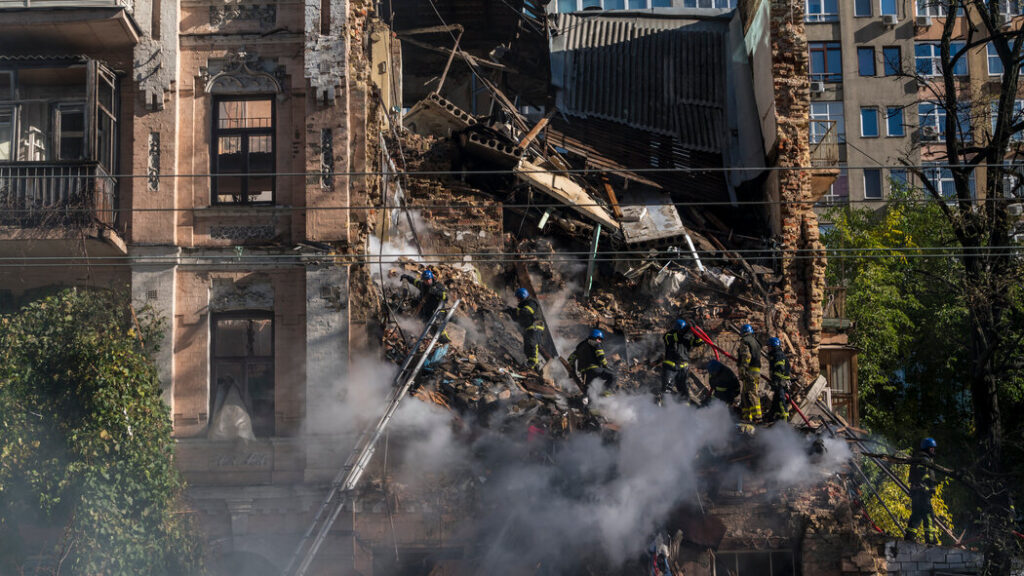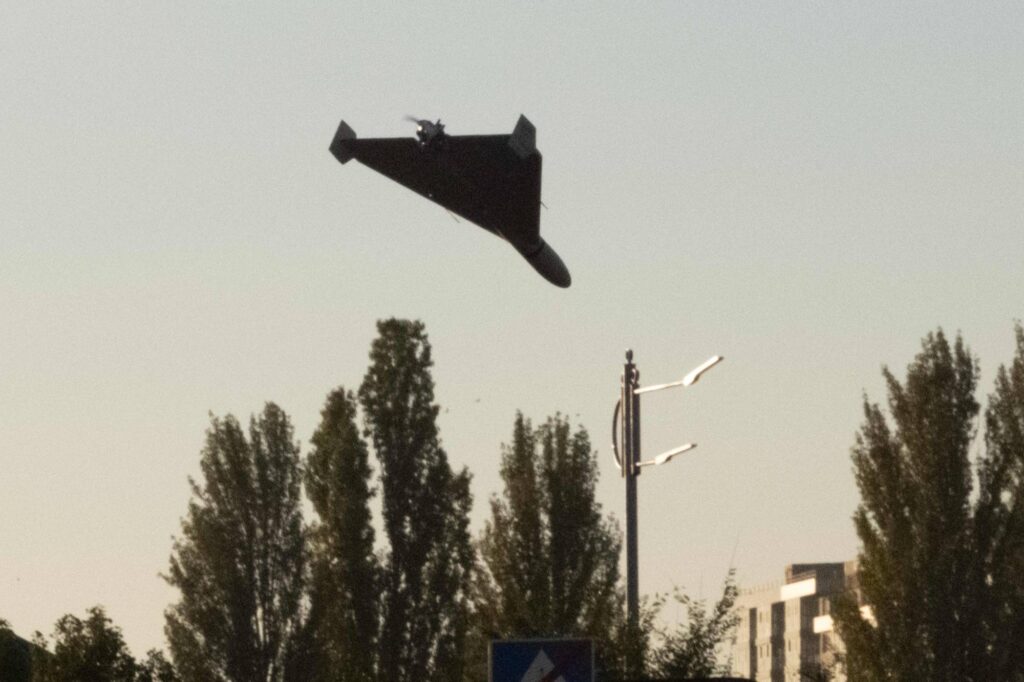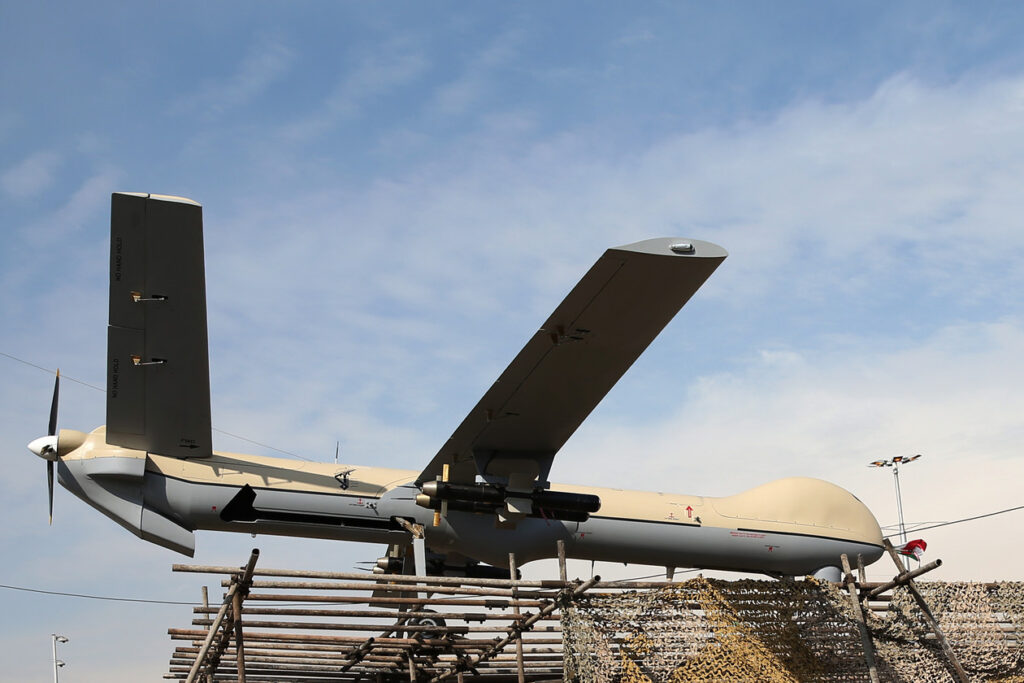Well-planned violence against civilians, aiming to achieve political goals

18 October 2022 – Today is the 237th day of the war in Ukraine. And the “air terror” continues. The bombing above was done by the new symbol of the Russian “army” – Iranian-made kamikaze drones, used in combination with cruise missile strikes. The building above was struck by one of those drones. 8 were killed, including a man and his pregnant wife. The whole of yesterday, all day and all night, reaching into this morning, Russia kept launching kamikaze drones. One journalist captured a photo just before one hit:

I’ll have more about these drones in the postscript to this post.
But in addition to apartment buildings, energy infrastructure is the clear target. This morning Russians targeted and hit:
– Thermal power plant in Dnipro city. Currently 30k households are without electricity.
– Thermal power plant in Kyiv. Currently 50k households are without electricity.
– Energy infrastructure in Zhytomyr city. Most of the city with 250k inhabitants is without electricity and water supplies
War crimes? Indeed. Terrorism? Absolutely. This is well-planned violence aiming to achieve political goals. Putin and his generals want to sow panic and desperation among Ukrainians. So no doubt they will continue their attacks on energy infrastructure, and the only limiting factor is the number of drones supplied by Iran.
BUT …
*Does it have any impact on the events at the frontline? No
*Does it really creates massive panic among civilians? No
*Will this terror allow Putin to gain his political goals? No
Even though most (85%) of these kamikaze drones and cruise missiles are being intercepted due to technology provided by the U.S., some of them still reach their primary energy infrastructure targets. Everybody understands that during upcoming cold months such strikes will cause more damage and will create many more problems for civilians in Ukraine. Repair brigades are performing miracles, relaunching energy supplies just hours after the strikes – working despite the threat of a double tap.
Still, in the long run, Ukraine cannot count only on its existing air defense and its capacity to repair after Russian attacks. Without multi-level air defense systems capable to deal with such terrorist attacks, and properly supplied with munitions, Ukraine will have a brutal winter. It is fighting against Russian invaders in the east and in the south of Ukraine, and desperately needs help to protect the air space from the Russian missiles and Iranian-made drones which will continue to attack its energy infrastructure.
POSTSCRIPT

ABOVE: the Iranian drone “Shahed-129”. The drone is 8 meters long with a height of 3.1 meters and a wingspan of 16 meters. It has a speed of 150 km/h, a flight range of 3,400 km, and an altitude ceiling of 7.3 km.
There are two models: the one in the photo further above in this post, and the one shown immediately above.
The strikes in Kyiv yesterday and today (it is estimated about 60 suicide drones were launched) marks a break in the use of drones in war. The aim here is to terrorize civilians and destroy civilian infrastructure, not to destroy the enemy army. It is estimated that Iran is shipping hundreds of these drones to Russia.
Wars have always been, as we know, the testing ground for new weapons. This one in Ukraine is no exception. The drone is not new to the battlefield, but what happened yesterday and today in Kyiv changes the use and the threat.
These drones are using rudimentary electronic warfare technology (some of it, ironically, supplied by U.S. tech companies) and cost only 20,000 euros each, whereas the large, super-sophisticated American armed drones can cost hundreds of thousands of euros each. It is a poor man’s weapon in a war where the most sophisticated equipment is also on display. But it is performing its task. And it is a weapon produced by a country whose arms industry is certainly not negligible, but which remains modest: Iran.
NOTE TO READERS: the drones carry smaller payloads and are much slower than such missiles, making them far easier to shoot down. But they are also much cheaper, so Russia can launch them in bunches, overwhelming air defenses and allowing some to reach their targets. The point is to target electricity, fuel, and other energy portals to attempt to economically exhaust Ukraine over time.
In fact, this drone-kamikaze (whose official name is “Shahed”, the “Martyr”) is a reflection of Iran, a country subject to severe sanctions – and which manages to manufacture its own equipment because it cannot import it freely. A pariah country, Iran has grown considerably closer to Russia in recent months: Putin even visited Tehran last July. The two countries are certainly side by side in Syria, with Bashar al-Assad, but they have never really been allies.
No, there is no deep love between Russia, newly a pariah for attacking another country, and Iran, for decades one of the most strategically isolated nations in the world. But the two authoritarian governments, both chafing under Western sanctions, share a view of the United States as their great enemy and a threat to their grip on power. This is a partnership of convenience between two embattled dictatorships. Both countries are deep in crisis, struggling economically and politically. Iran is attempting to quell street protests that pose the most serious challenge in years to the government, while Russia is trying to manage rising dissension over a faltering war effort and an unpopular draft.
The emergence of a Moscow-Tehran alliance has multiple international implications, and far too complex for this post, but it certainly dims the prospects for a new agreement to rein in Iran’s nuclear program – and raised the pressure on Israel, Iran’s sworn enemy, to take Ukraine’s side in the war. Hence Russia’s warning to Israel to “tread carefully”. Because the U.S. would love Israel to take out Iran’s drone manufacture sites and drone bases.
The relationship between Russia and Iran has been developing for years. As I noted in a post a number of years ago, Putin deployed his air force to Syria starting in 2015 to prevent the collapse of the regime of al-Assad, a longtime ally of Tehran. Russia and Iran worked in lock step militarily, with Russian warplanes providing cover for Iranian militiamen and Iranian proxy forces fighting on the ground. Syria was just one example of the effort by both to find ways to sap American strength and prestige wherever they could in the world, and Ukraine provides a similar opportunity on an even larger, more visible scale.
And while Iran has delivered (or will deliver) 100s of these “Shahed” drones to Russia, filling a gap in the Russian system, Ukraine, for its part, even before the Russian invasion, was buying Turkish-made armed drones, Bayraktars, named after the manufacturer who is none other than the son-in-law of Turkish President Erdogan. It has also received American Switchblade suicide drones.
But Kiev has made more conventional use of them, to destroy tanks or artillery, while the appearance of the Iranian drone in the skies of Kyiv, with the sole purpose of terrorizing the population, constitutes a break.
And so today there is a race is for drones, and also a race for anti-drone systems, because at this price, the drone-kamikaze is within reach of any terrorist group. Hence Ukraine’s request for more efficient systems.
The attacks yesterday and today will be scrutinized and analyzed by every Western military establishment to draw lessons from it. For the Ukrainians, it is death from above, for only 20,000 euros. A sinister evolution of the art of war.
And the political machinations are byzantine. Iran is not actively highlighting the weapons sales because Ukraine is generally more popular than Russia among ordinary Iranians, and the Islamic Republic casts itself as a defender of underdogs in world affairs. But at the same time, Iran also wants to show the world that it has a military superpower as an ally and it has the capacity to sell weapons to such a power. It shows the West’s policies of maximum pressure to isolate Iran have not worked.
I am in the process of updating my monograph on drones (only one year old and already out of date) and that should be done in a few weeks. It is normally a pay-per-view item in my catalog of monographs but the update shall be issued with free access.